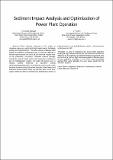JavaScript is disabled for your browser. Some features of this site may not work without it.
| dc.contributor.author | Namgyal, Lhendup | |
| dc.contributor.author | Tandin | |
| dc.date.accessioned | 2021-09-17T14:56:21Z | |
| dc.date.available | 2021-09-17T14:56:21Z | |
| dc.date.issued | 2019-03-10 | |
| dc.identifier.uri | http://repo.sltc.ac.lk/handle/1/118 | |
| dc.description.abstract | The sediments transport in the rivers in Himalaya region are significantly high mainly due to the fragile geology and rugged terrain. This poses serious challenges with regards to sediment management, loss in reservoir capacity in the hydro power plants and above all, the sediment induced wear on the underwater components. Sediment induced damages include the costs of repair works and replacement investments due to hydro abrasive erosion and losses of revenue due to reduced turbine efficiency or downtime during replacement/repairing works. It is therefore, economical to close the water intake and stop the turbine operation when Suspended Sediment Concentration (SSC) and particle sizes exceed limit values. While the effect of Particle Size Distribution (PSD) on turbine erosion is not yet fully known, switch –off decision are so far based on SSC.Therefore, in view of optimizing the power plant operation during the high sediment period and also to improve the life and efficiency of the turbines, the sediment impact assessment were carried out for the four high head power plants in Bhutan based on the guidelines provided in IEC 62364 and accordingly optimal SSC were estimated for each power plants for the switch off decision. | en_US |
| dc.language.iso | en | en_US |
| dc.publisher | ETIC conference | en_US |
| dc.subject | Suspended Sediment Concentration | en_US |
| dc.subject | ParticleLoad, Efficiency, | en_US |
| dc.subject | Switch-off | en_US |
| dc.title | Sediment Impact Analysis and Optimization of Power Plant Operation | en_US |
| dc.type | Article | en_US |
